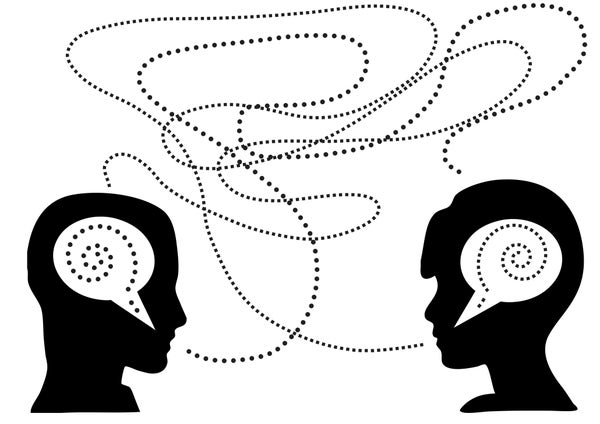Last November, I ran an episode on the myth that the Inuit language has a surprisingly large number of words for “snow.” I talked about how this myth is one example of a widely debunked idea called the Sapir-Whorf hypothesis, named after the linguists Edward Sapir and Benjamin Whorf. This hypothesis claims that the language you speak determines the way you think, or at least influences it. This hypothesis is also sometimes called linguistic relativity. Here’s one of the arguments against the idea of linguistic relativity that I summarized in that episode.
[M]ultiple languages have just one word that covers both the color blue and the color green. Researchers sometimes call these “grue” languages, “grue” being a portmanteau of “green” and “blue,” but people who speak these grue languages can still distinguish between blue and green. They recognize that they’re different colors even though they are covered by one word, in the same way that we recognize that light blue and dark blue are different colors even though we’d sometimes call them both just “blue.” There are some subtle differences—people who speak languages that distinguish between green and blue find it easier to accurately pick a bluish-green color they’ve seen earlier out of a group of swatches because it’s easier to remember something you have a distinct name for—but it’s not that they are better at recognizing or conceiving the difference between blue and green (1).
However, I recently read an article in “Smithsonian” magazine that seemed to challenge this view. It was about a court ruling in Germany saying it is unconstitutional for government institutions to assume that every person is either male or female. Any government form that people fill out now must have either a third gender to allow for people who identify as neither male nor female, or no gender question at all. The author of the article, Madhvi Ramani, argued that this ruling would be particularly troublesome for Germans, because German is a strongly gendered language (2). For example, you don’t just say you are a teacher. You are either a male teacher (der Lehrer) or a female teacher (die Lehrerin), and the author argued that this leads the German people to be especially partial to the idea of gender as a binary construct.
On supporting science journalism
If you're enjoying this article, consider supporting our award-winning journalism by subscribing. By purchasing a subscription you are helping to ensure the future of impactful stories about the discoveries and ideas shaping our world today.
So which is it? Can the language you speak influence your thoughts, or can’t it? The short answer is: Yes it can, but it’s not the kind of mind-blowing influence that people usually have in mind.
What kind of mind-blowing influence are we talking about that isn’t actually real? For my money, the best example is the science fiction movie “Arrival” from 2016. I won’t spoil it for those who haven’t seen it, but I can say this much: The protagonist, a linguist named Louise Banks, learns the language of some alien visitors to Earth, and doing so changes the way her mind works so much...that it’s a major plot point. In fact, it’s the basis of the big reveal near the end of the movie.
Linguistic Relativity and Color Names
Now, on to some aspects of language where people have done research to test the idea of linguistic relativity. Most of these examples come from “Language Files,”a textbook published by the Ohio State University Department of Linguistics, and a great TED talk by Lera Boroditsky (3), a linguist at UC San Diego who is the leading expert on linguistic relativism.
First, let’s talk about color names a little more. A famous study in 1969 by Brent Berlin and Paul Kay did not find evidence for linguistic relativity when it came to color names. Instead, they found that languages tended to follow similar patterns in what colors they had names for, and in the order in which they gained new color terms (4).
On the other hand, in favor of linguistic relativity are the facts about color terms that I mentioned earlier: People who speak languages that distinguish between green and blue find it easier than people who don’t to sort green and blue swatches into piles. There are similar results from the language Zuñi, which uses the same word for both yellow and orange (5).
»Continue reading “Does Your Language Influence How You Think?” on QuickAndDirtyTips.com
